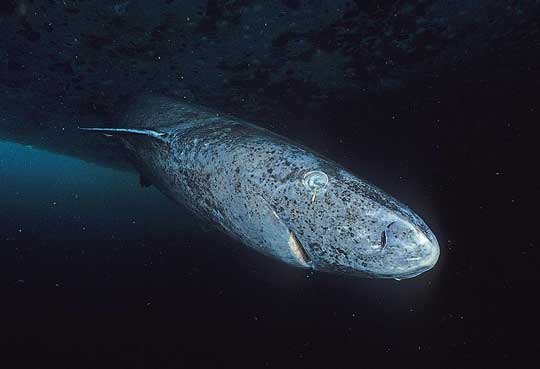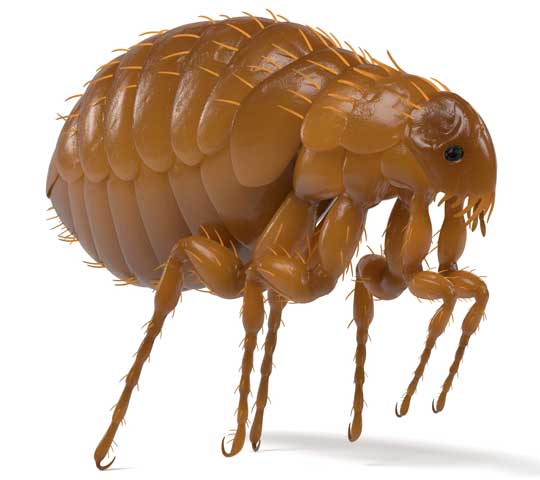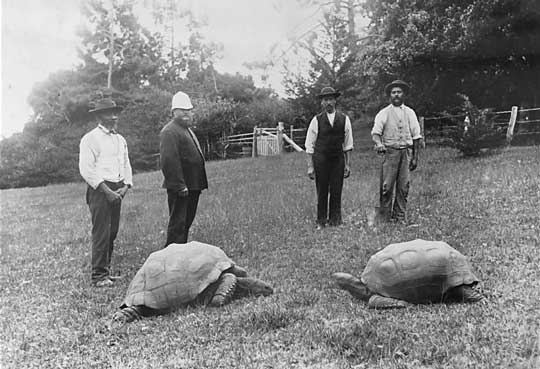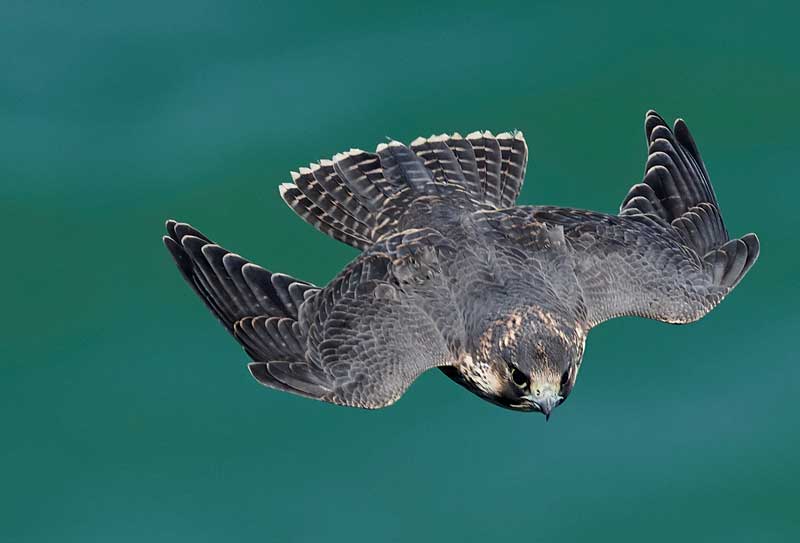|
Did you know there is a shark that can live more than 270 years? In my last email I featured a tortoise that was 190 years old, perhaps the oldest land animal. Well, the Greenland shark can live at least 272 years, and possibly 512 years or more.
I'll explain how we know this. Scientists have long guessed that Greenland sharks were old based simply on the fact that they grow only about 1 cm per year, and some are six meters long. But that's just guessing. Other types of sharks can be accurately aged by counting the growth rings on their vertebrae (or on the spines of their fins), but Greenland sharks don't have any hard tissue in their backbones, and they don't have fin spines. So, the ring-counting trick doesn't work. Recently, though, scientists discovered certain proteins in the eyes of Greenland sharks that form before they are born and do not change throughout their entire lives. They found that they could age the sharks by carbon-dating these proteins. It's important to point out that they didn't catch and kill Greenland sharks specifically for this study. Instead, they used sharks that were accidentally caught in fishermen's nets. Anyway, one of the sharks they looked at was 5 meters long. Its eye proteins were carbon-dated to be between 272 and 512 years old (carbon dating gives you a range rather than a specific age). Why do Greenland sharks live so long? Mostly because they live in really cold water and have a really slow metabolism. Here's one more tidbit to blow your mind: Greenland sharks grow so slowly that biologists think they do not even become sexually mature until they are over a century old!
0 Comments
Did you know fleas are good jumpers? I don't mean so-so jumpers or pretty good jumpers, I mean really good jumpers. A variety of flea species have been studied for their jumping abilities (biologists are curious people, are they not?). One study looked at the jumping distance of 450 cat fleas (Ctenocephalides felis), and found that the average vertical jump is 5.2 inches (13 cm) and the average horizontal jump is 8 inches (20 cm). The very longest horizontal jump was 19 inches (48 cm).
This may not sound like much distance, but you need to consider that a cat flea is less than 3 mm long. Nineteen inches is essentially 160 time the flea's body length. Okay, I'm about 5 foot 10 inches (177 cm) tall. If I could jump like the most athletic cat flea in that research study, I would hit the ground 933 feet from where I left the ground. That's longer than three football fields. Not only can fleas jump far, they also jump incredibly fast. A flea completes its launch in less than one millisecond. This speed is much faster than would be possible with normal muscle movement. Instead of using their muscles to jump, they use their muscles to bend a part of their exoskeleton called the pleural arch. This acts as a spring, and when it releases, it throws the flea into the air with great force. Think of it like shooting a bow. Instead of using your muscles to throw the arrow, you use them to pull the bow string back. Awesome Animal Fact:
Did you know the Nile crocodile has the strongest bite of all animals? Bite force is typically measured in pounds per square inch (psi). For perspective, the average bite force for a human is 162 psi. If you've ever had a little brother or sister, you know how much a human bite can hurt, am I right? With the human bite force as our reference point, let's look at the bite forces of some of the animals with the most powerful jaws. For example, a hyena can bite at 1,100 psi. Youch! That is definitely bone-crunching power. But the hyena isn't close to the most powerful. A polar bear? 1,200 psi. A gorilla? 1,300 psi (gorillas aren't predators, but they like to tear bark off of trees with their teeth). A jaguar? 1,500 psi (definitely a predator). A hippo? 1,800 psi (hippos are really good at defending themselves from those apex African predators). A saltwater crocodile? 3,700 psi. Seriously? 3,700 psi? Finally, the champ, the Nile crocodile, at 5,000 psi. Those dudes like to crush their huge prey before swallowing them whole. Wait! What about great white sharks? Don't they have pretty strong jaws? They do, but no one has been able to measure the force with a live specimen. Maybe they just aren't very cooperative study subjects? However, by using multiple x-ray images to create computer models of the skull of a great white, scientists have estimated the bite force to be about 4,000 psi, which would put the great white in second place. Still, the Nile crocodile is the champ of chomp. Did you know there is a tortoise that is 190 years old? Jonathan the tortoise is estimated to have hatched in 1832. This estimate is based on a letter written in 1882, when Jonathan arrived on St. Helena, a remote island in the south Atlantic under British control. The tortoise was originally captured from the Seychelles Islands in the Indian Ocean. In the letter, Jonathan was described as "fully grown." When it comes to giant tortoises, "fully grown" generally means at least 50 years old. So, it's quite possible Jonathan is older than 190. To this day, Jonathan is still wandering around on the grounds of the governor's residence on St. Helena. Again, let's put this into perspective. Jonathan has lived on the Governor's lawn while 31 different St. Helena governors have come and gone. Jonathan was alive when Andrew Jackson was president of the US, and through the terms of the next 39 US presidents. The very first automobile, called the "Motorwagen," was patented in 1886 by Karl Benz. Jonathan was at least 54 years old then. January 1, 1983 is considered the official birthday of the Internet. Jonathan was at least 152 on that day. Although there are aquatic animals that probably live longer (sharks, for example), Jonathan may be the oldest terrestrial animal alive today. Jonathan is now losing his eyesight, but he has a dedicated veterinarian who feeds him by hand. In spite of his age, Jonathan still mates with the other tortoises living on the grounds of the governor's residence, including the one named Fred. Jonathan doesn't seem to care about minor details like gender. The photo below was taken in 1886, four years after Jonathan arrived at the Governor's residence. Jonathan is the tortoise on the left. Photo Credits: - 1886 photo of Jonathan the tortoise - Unknown photographer, Public domain, via Wikimedia Commons Did you know blue whales are really big? You probably did know, but let's bring this into perspective. An adult blue whale's heart is the size of a Volkswagen Beetle... really. A heart the size of a car.
Blue whales grow to 100 feet (30.5 m) in length, and they weigh about 400,000 pounds (181,437 kilograms). Because I'm already measuring things in VW Beetles, this is the equivalent of 135 VW Beetles. Wait... that was measured in VW Beetles manufactured in 2003, which weigh about 2,900 pounds each. A 1960 VW Beetle weighs only 1,600 pounds. So, actually, if we want to use the 1960 Beetle as a unit of weight, a blue whale is equivalent to 250 VW Beetles. That sounds even more impressive. Let's keep going with this. A blue whale's tongue (just the tongue), weighs 5,400 pounds (2,449 kg). Yep, a tongue with the mass of 3.3 VW Beetles (of the 1960 variety). Finally, blue whales give birth to the largest babies of any living animals. Newborn babies are 26 feet (8 m) long and weigh 8,000 pounds (3,629 kg). So... (drumroll please) mother blue whales give birth to something that is the equivalent of FIVE Volkswagen Beetles. We need a moment of silence to let that sink in. Did you know there's a fish that can swim faster than a cheetah can run? Yep, it's the black marlin. Cheetahs have been clocked at up to 75 miles per hour (120 km/hr). However, a black marlin that was hooked by a fisherman was recorded stripping line off the fishing reel at 120 feet per second. That's 82 miles per hour (132 km/hr). I find this to be amazing because the fish is swimming through water, which creates much more resistance than air.
Hmmm... let's think about this, though. Actually, the marlin is swimming, which is kind of like flying through the water, right? Therefore, maybe we should compare the marlin's speed to the speed of something flying through the air instead of running. The fastest flying animal is the peregrine falcon, clocked at an astounding 242 miles per hour (389 km/hr). That's three times faster than the marlin can swim. The peregrine is not only the fastest flyer, it is the fastest animal in the entire animal kingdom. I should point out that the peregrine falcon does not fly this fast when it is moving horizontally. Instead, the falcon achieves this speed when in its high-speed hunting dive (called a hunting stoop). The bird flies to a great height, then it dives at its prey (another flying bird) at over 200 miles per hour. Interestingly, the falcon is careful to strike one wing of the bird, not the body, to keep from smashing itself to smithereens. This breaks the prey bird's wing, making it easy for the falcon to then finish it off. Did you know giant pandas eat 25 to 90 pounds (12-38 kg) of bamboo every day? Bamboo is pretty much all pandas eat—bamboo leaves, shoots, and stems. Fourteen hours per day eating bamboo.
The question is, why do they eat so much of the stuff? Recent research has provided some answers. It turns out that pandas have microbes in their gut that are more similar to the microbes of carnivores and omnivores than to those of herbivores. Actually, they don't have any of the microbes needed to digest cellulose, which is the stuff in plant cell walls that make plants hard for humans to digest. So, pandas have to eat a lot of bamboo because they can only digest about 17% of the bamboo they eat. Pandas evolved from omnivore ancestors, not from herbivores, and they began specializing in eating bamboo about seven million years ago. During those seven million years, they never developed a highly efficient way to break down cellulose. They simply do not have the genes necessary to produce plant-digesting enzymes. For this reason, many scientists believe pandas are at an evolutionary dead end, and this may have increased their risk of extinction. Fortunately, conservation efforts are helping to preserve at least some of the panda's native bamboo forests. |
Stan's Cogitations
Everyone needs a creative outlet. That's why I write. Archives
July 2024
|








 RSS Feed
RSS Feed